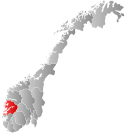|
Fana (municipality)
Fana is a former municipality in the old Hordaland county in Norway. The municipality was located in the central part of the Bergen Peninsula, south of the city of Bergen. The administrative centre of the municipality was the village of Nesttun. The roughly 200-square-kilometre (77 sq mi) municipality existed from 1838 until 1972 when it had 44,402 residents, making it one of the most populous municipalities in the nation. The area of the former municipality encompassed the southern half of the present-day Bergen Municipality in Vestland county, it specifically included the present-day boroughs of Fyllingsdalen, Ytrebygda, and Fana, as well as the southern part of the borough of Årstad.[3] The historic Fana Church was the main church for the municipality. History  The parish of "Fane" was established as a formannskapsdistrikt, the predecessor of today's municipalities ("kommune"), on 1 January 1838. The spelling was later changed to "Fana". In 1879, a small area of Fana (population: 18) was transferred to the Laksevåg area of the neighboring Askøy Municipality.[4] On 12 August 1955, the northern part of /the Fyllingsdalen valley in Fana (population: 1,590) was sold to the city of Bergen for 1.5 million kr. This gave the city a lot of room to grow. On 1 January 1966, another small border adjustment took place: a small part of Fana located along the lake Ortuvatnet in Fyllingsdalen (population: 4) was transferred to the city of Bergen.[3][4] On 1 January 1972, the municipality of Fana (population: 44,402) was merged into the city of Bergen in addition to the other neighboring municipalities of Arna, Laksevåg, and Åsane, forming a much larger city-municipality of Bergen.[4] NameThe municipality (originally the parish) is named after the old Fana farm (Old Norse: Fani) since the first Fana Church was built there. The meaning of the name is uncertain and there are several possibilities for its meaning. One option is that it is the dative case of fana which means "swamp" or "marshland". Another possibility is that it comes from a local dialect word faan which means "dust" or "ash". A third possibility is that it comes from a Gothic language word fana which means "piece of cloth". Regardless of its meaning, it is thought that the farm was named after the local Fanafjorden or a local mountain.[5] Historically, the name of the municipality was spelled Fane. On 3 November 1917, a royal resolution changed the spelling of the name of the municipality to Fana.[6] GovernmentDuring its existence, this municipality was governed by a municipal council of directly elected representatives. The mayor was indirectly elected by a vote of the municipal council.[7] Municipal councilThe municipal council (Kommunestyre) of Laksevåg was made up of 53 representatives that were elected to four year terms. The party breakdown of the final municipal council was as follows:
MayorsThe mayors (Nynorsk: ordførar) of Fana:[16]
See alsoReferences
|
||||||||||||||||||||||||||||||||||||||||||||||||||||||||||||||||||||||||||||||||||||||||||||||||||||||||||||||||||||||||||||||||||||||||||||||||||||||||||||||||||||||||||||||||||||||||||||||||||||||||||||||||||||||||||||||||||||||||||||||||||




